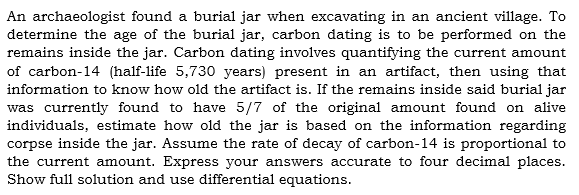An archaeologist found a burial jar when excavating in an ancient village. To determine the age of the burial jar, carbon dating is to be performed on the remains inside the jar. Carbon dating involves quantifying the current amount of carbon-14 (half-life 5,730 years) present in an artifact, then using that information to know how old the artifact is. If the remains inside said burial jar was currently found to have 5/7 of the original amount found on alive individuals, estimate how old the jar is based on the information regarding corpse inside the jar. Assume the rate of decay of carbon-14 is proportional to the current amount. Express your answers accurate to four decimal places. Show full solution and use differential equations.
An archaeologist found a burial jar when excavating in an ancient village. To determine the age of the burial jar, carbon dating is to be performed on the remains inside the jar. Carbon dating involves quantifying the current amount of carbon-14 (half-life 5,730 years) present in an artifact, then using that information to know how old the artifact is. If the remains inside said burial jar was currently found to have 5/7 of the original amount found on alive individuals, estimate how old the jar is based on the information regarding corpse inside the jar. Assume the rate of decay of carbon-14 is proportional to the current amount. Express your answers accurate to four decimal places. Show full solution and use differential equations.
Chapter6: Exponential And Logarithmic Functions
Section: Chapter Questions
Problem 29PT: A radiation safety officer is working with 112 grams of a radioactive substance. After 17 days,...
Related questions
Question

Transcribed Image Text:An archaeologist found a burial jar when excavating in an ancient village. To
determine the age of the burial jar, carbon dating is to be performed on the
remains inside the jar. Carbon dating involves quantifying the current amount
of carbon-14 (half-life 5,730 years) present in an artifact, then using that
information to know how old the artifact is. If the remains inside said burial jar
was currently found to have 5/7 of the original amount found on alive
individuals, estimate how old the jar is based on the information regarding
corpse inside the jar. Assume the rate of decay of carbon-14 is proportional to
the current amount. Express your answers accurate to four decimal places.
Show full solution and use differential equations.
Expert Solution
This question has been solved!
Explore an expertly crafted, step-by-step solution for a thorough understanding of key concepts.
Step by step
Solved in 3 steps

Recommended textbooks for you



College Algebra (MindTap Course List)
Algebra
ISBN:
9781305652231
Author:
R. David Gustafson, Jeff Hughes
Publisher:
Cengage Learning



College Algebra (MindTap Course List)
Algebra
ISBN:
9781305652231
Author:
R. David Gustafson, Jeff Hughes
Publisher:
Cengage Learning

Algebra & Trigonometry with Analytic Geometry
Algebra
ISBN:
9781133382119
Author:
Swokowski
Publisher:
Cengage